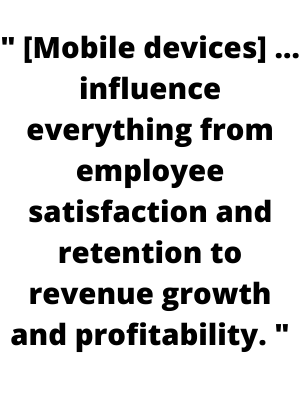TL;DR
- Mobile services (workforce mobility) are essential to do business; business mobile services spend represents around 7.6% of business IT spend globally.
- Cost management is fundamental to profitability and is seeing an increased focus with businesses prioritising IT initiatives towards cost savings from 9% in 2020 to 27% in 2021.
- Workforce mobility analysis has shown that BYOD (Bring Your Own Device) is no longer as cost-effective as it was and blended EPD (Employer Provided Device) schemes tend to provide greater productivity and cost balance.
- One size does not fit all for employees in terms of optimizing mobile service and price. The ability to pick-and-mix mobile service providers and plans enables a cost and quality balance across the workforce.
- A web-based (SaaS) Telecoms Expense Management (TEM) platform to simplify and manage mobile service procurement and administration, including consolidated billing, reduces the hidden costs of enterprise mobility.
Cost management is fundamental
According to Forrester Research (link here via telecomlead.com), businesses globally spend around 7.6% of their IT budget on mobile telecoms. That’s a lot! And with the effect of the global pandemic still in play, cost pressures are mounting for businesses riding out the wave. Of course, we invest in new areas for growth and customer experience, but we must ensure that we do not simply squander the hard-earned cash that our customers part with to enjoy our products and services. Thoughtless spending benefits few, especially in these demanding times.
According to a recent survey by Flexera, CIOs are increasing their focus on cost savings from 9% of respondents prioritising cost saving initiatives in 2020 to 27% in 2021.
Cost management is a challenge for businesses of all shapes and sizes. Small businesses are often very cost-conscious but may lack the depth of knowledge to really optimize their spend. Larger businesses and corporates often invest in their procurement processes to get better pricing and/or value from suppliers. However, purchasing processes can be overly complicated and rarely consider the hidden costs of service management or quality challenges in procurement decisions.
The business mobile services cost challenge
In mobile services there is a real mix of approaches in play. Some businesses offer employees a (stipend) payment to cover their business mobile expenses, with a Bring Your Own Device (BYOD) policy in place. Some issue both the hardware and the service, often meaning that employees have to carry a second device for personal use. Others mandate specific monthly expense claims for business mobile service usage on their personal accounts. And there are other variations with new options now presenting with the proliferation of eSIM enabled devices.
As the business grows, the approach to mobile services established early on is often ‘taken for granted’ and rarely revisited unless there is a trigger to do so. But in today’s increasingly cost-conscious business world, those responsible for keeping an eye on profitability are now becoming more proactive in their search for cost savings or improved productivity.
The opportunity for savings and efficiency are not always based solely on the direct costs of the service. Often, the hidden costs of complex service management can take a real toll. And when you consider the less tangible impact of poor mobile service quality on the employee and customer base, you get to see some real opportunity in change.
Some truly believe in the ‘simplicity’ of paying a stipend, but is that really the best solution? What is the real cost of that policy, direct and indirect, over the longer term? Also see our commentary on the associated tax challenges with BYOD.
What does the data say?

In the June 2018 Oxford Economics survey report ‘Maximizing Mobile Value: Is BYOD holding you back?’ 31% of businesses worked as BYOD and 69% in some form of limited or full Employer-Provided Device (EPD) regime. Those with targeted EPD rollout, rather than full EPD or BYOD, tended to report better value from their mobility policies.
The report makes it clear that workforce mobility is essential, and that hidden costs are more troubling than one might think:
- 80% of respondents say that employees cannot do their jobs effectively without a mobile phone, and 75% say mobile devices are essential to workflows.
- Mobile service administration for BYOD, especially when incorporating Mobile Device Management (MDM), is bigger thanyou think; complexity means cost. Where devices are provided to employees, device acquisition costs represent only 10%–13% of the total spent for enabling an employee over two years.
- BYOD respondents report lower satisfaction rates with mobile devices as work tools (69%, vs. 78% or more for those who provide devices to a significant portion of their workforce).
- 53% of organisations say that a lack of interoperability between mobile devices and other corporate apps and systems is at least somewhat challenging.
The report also concludes that over two thirds of businesses expect their employees to be available after hours, remotely, even if the company does not provide the devices. Accordingly, companies are now paying significantly more in stipend than they were just two years before, assuming more of the employee cost to warrant this need.

Source: June 2018 Oxford Economics survey report Maximizing Mobile Value: Is BYOD holding you back?
The cost balance has changed as more stipend is demanded and so BYOD is increasingly less attractive as an approach to mobility. This is emphasised by the report’s analysis depicting the actual cost, but that analysis does not factor-in the benefits of productivity, integrated solutions and potential landline savings. When looking at incorporating these other benefits in the mix, the case for BYOD is weak. See also the well-considered article from Samsung: A Fresh Look at BYOD and the Potential Hidden Costs (August 2019).
Is quality really an issue?
Many business buyers of mobile services do so under a blanket approach; one size fits all. Although this simplifies procurement, usually via a single network services provider (e.g. Verizon, AT&T, T-Mobile), the approach often exposes the business to inappropriate costs and service issues. Let’s take an illustration of a company with a mobile workforce, e.g. field engineers:
- Jake doesn’t get great service coverage at home and so he misses some jobs and calls.
- Sue gets great coverage at home to receive scheduled jobs each day, but on the road she works in an area where the contracted mobile network has poor coverage so she misses schedule changes and wastes time attending appointments that are cancelled.
- Marco keeps running out of data as he relies more on service apps and chat groups, and regularly sends downloads of helpful videos and instruction manuals to his customers after a service call.
- Sofia uses very little data but she’s on the same data plan as all other employees and that’s just a waste of money.
In reality, one size rarely fits all. A tailored approach is always going to produce the best cost-quality balance: custom design of the mobility solution to the business and workforce needs. As indicated in the survey above, businesses taking a tailored approach to their employee mobile service policy reach better efficiency and productivity levels. And where customer communications are imperative from the mobile platform, customer experience is directly affected.
The key message here is: always consider business and unique employee needs and quality challenges in designing the enterprise mobile services policy and implementation approach. Good design and implementation pay huge dividends in employee morale, productivity and customer satisfaction, and costs a lot less than a blanket approach.
Minimising the hidden costs, optimizing the quality balance
Complications often continue through the administration processes for the mobile services procured and can manifest in both workforce and services provider engagement channels. Good mobile service partners make a world of difference to the quality and cost of administrative operations. You know this if you have suffered the bad ones!
Outsourcing the management of the mobility solution is very common in larger businesses, and increasingly popular in smaller businesses that wish to focus their energy on their core business and customer experience. Managing mobile service partners is a distraction and can offset any perceived cost savings.
Where full or partial EPD schemes are in place, Telecom Expense Management (TEM) automation really helps to reduce overheads and improve accuracy. Your mobile services provider should ideally provide the platform as part of their service package, or if you already have a generic expense management solution in place, integrate their billing to that platform. A complete service management platform, enabling procurement, activation, billing, deactivation and the fulfilment of plans and lines also provides significant efficiencies for your business. Importantly, an account management team with voice and digital (portal or integrated support platform) access is important to avoid call-centre queues and keep the correct level of control in place in your service regime.
The TEM reporting should also enable good oversight of expenses and/or integrate to your existing reporting platforms. You want to avoid having to manually produce reports or, worse still, enter billing and user data directly in your systems. Integration to other business planforms, such as Slack or Salesforce, will also be a bonus. Ask your service provider what they can do.
Last but not least, if you are able to tailor your business mobile services to the unique business and employee needs, with multiple networks and plans in the mix, you want to have a simple billing solution that combines these. Reconciling multiple bills and usage is a significant cost and is fraught with errors that can delay accounting practices and, depending on the nature of your mobile policy, may also affect the employees directly too.
Conclusion
Many businesses are now freeing themselves from the shackles of traditional mobile service policies and suppliers with the goal of improving quality and reducing costs. They want to focus on their core business and customer experience.
The ability to mix-and-match mobile networks and service plans to align with your chosen employee mobility policy brings huge cost-quality benefits. With eSIM and TEM solutions adding to the value that the right service provider can bring it is increasingly easy to pass the hard work onto a trusted partner to bring in these benefits for you.






